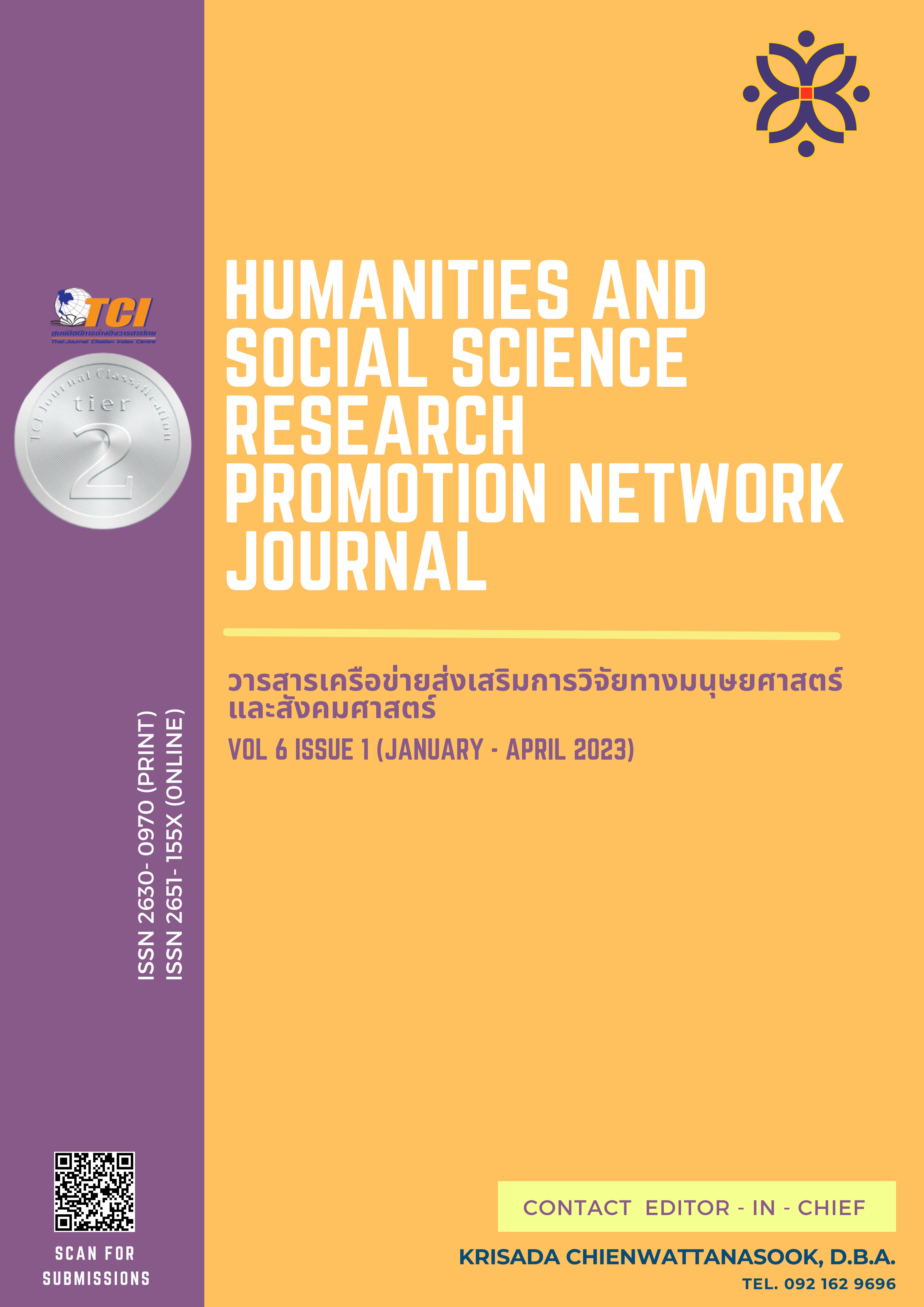ปัจจัยจูงใจที่ส่งผลต่อความผูกพันต่อของพนักงาน: กรณีศึกษา บริษัท Liaoning Haolian Zhongfan Investment Co., Ltd. China
คำสำคัญ:
ปัจจัยจูงใจ , ปัจจัยค้ำจุน , ความผูกพันของพนักงานบทคัดย่อ
ความล้มเหลวของบริษัทในการทำความเข้าใจเกี่ยวกับปัจจัยจูงใจที่ส่งผลต่อความผูกพันของพนักงานนั้นอาจส่งผลให้เกิดปัญหามากมาย รวมถึงอัตราการลาออกที่สูง ประสิทธิภาพที่ลดลง ขวัญกำลังใจต่ำ การตัดสินใจที่ไม่ดี และความสามารถในการแข่งขันของบริษัทลดลง พนักงานที่ไม่มีความผูกพันนั้นมีโอกาสน้อยที่แสดงการมีส่วนร่วมในการตัดสินใจ ส่งผลให้บริษัทขาดความคิดสร้างสรรค์และสูญเสียแนวคิดและข้อเสนอแนะที่ลึกซึ้ง การวิจัยนี้จึงมีวัตถุประสงค์เพื่อศึกษาปัจจัยจูงใจและปัจจัยอนามัยที่ส่งผลต่อความผูกพันของพนักงานของบริษัท Liaoning Haolian Zhongfan Investment Co., Ltd. China. ประชากรที่ใช้ในการวิจัยนี้ คือ พนักงานบริษัท Liaoning Haolian Zhongfan Investment Co., Ltd China. โดยใช้แบบสอบถามเป็นเครื่องมือในการเก็บรวบรวมข้อมูลจากกลุ่มตัวอย่างจำนวน 300 คน ทำการวิเคราะห์ข้อมูลด้วยค่าความถี่ ร้อยละ ค่าเฉลี่ย ส่วนเบี่ยงเบนมาตรฐาน และทดสอบสมมติฐานด้วยการวิเคราะห์การถดถอยพหุคูณ
ผลการวิจัยพบว่า ปัจจัยจูงใจ ได้แก่ ความสำเร็จ ความรับผิดชอบ ลักษณะของงาน ความก้าวหน้า และโอกาสในการเติบโต ส่งผลต่อความผูกพันของพนักงานของบริษัท Liaoning Haolian Zhongfan Investment Co., Ltd. China อย่างมีนัยสำคัญทางสถิติที่ระดับ .05 โดยมีอำนาจในการพยากรณ์ร้อยละ 86.3 และปัจจัยอนามัย ได้แก่ สภาพการทำงาน เงินเดือนและผลประโยชน์ ความสัมพันธ์กับเพื่อนร่วมงาน ชีวิตส่วนตัว ความสัมพันธ์ระหว่างผู้ใต้บังคับบัญชา และสถานภาพ ส่งผลต่อความผูกพันของพนักงานของบริษัท Liaoning Haolian Zhongfan Investment Co., Ltd. China อย่างมีนัยสำคัญทางสถิติที่ระดับ .05 โดยมีอำนาจในการพยากรณ์ร้อยละ 91.2
เอกสารอ้างอิง
Akingbola, K., & Van Den Berg, H. A. (2019). Antecedents, consequences, and context of employee engagement in nonprofit organizations. Review of Public Personnel Administration, 39(1), 46-74.
Gubman, E. (2004). HR strategy and planning: from birth to business results. People and Strategy, 27(1), 13.
Herzberg, F. I., Mausner, B. & Snyderman, B. (1959). The motivation to work. New York: Wiley.
Kaushik, M., & Guleria, N. (2019). Employee relations and engagement during COVID-19. Employee Relations, 2(3).
Khongsawatkiat, K., & Sukriket, P. (2021). The causal relationship model of human resource management to the organizational commitment of employees in agro-processing industries. Humanities and Social Science Research Promotion Network Journal, 4(1), 1-30.
Kuswati, Y. (2020). The effect of motivation on employee performance. Budapest International Research and Critics Institute-Journal (BIRCI-Journal), 3(2), 995-1002.
Pesadcha, T. (2022). Book review: human resource planning strategies. Journal of Value Chain Management and Business Strategy, 1(1), 67-68.
Pholsward, R. (2022). What graduates needs in entering the job market. RICE Journal of Creative Entrepreneurship and Management, 3(3), 67-70.
Pincus, J. D. (2022). Employee Engagement as Human Motivation: Implications for Theory, Methods, and Practice. Integrative Psychological and Behavioral Science, 1-33.
Riyanto, S., Endri, E., & Herlisha, N. (2021). Effect of work motivation and job satisfaction on employee performance: Mediating role of employee engagement. Problems and Perspectives in Management, 19(3), 162-174.
Santana-Martins, M., Nascimento, J. L., & Sánchez-Hernández, M. I. (2022). Employees’ emotional awareness as an antecedent of organizational commitment-The mediating role of affective commitment to the leader. Frontiers in Psychology, 13.
Siddiqui, M. N. (2014). Success of an Organization is a result of Employees Performance. Advances in Social Sciences Research Journal, 1(4), 179-201.
Swarnalatha, C., & Prasanna, T. S. (2013). Employee engagement: The concept. International Journal of Management Research and Reviews, 3(12), 3872.
Yamane, T. (1973). Statistics: an introductory analysis. New York: Harper. & Row.
ดาวน์โหลด
เผยแพร่แล้ว
รูปแบบการอ้างอิง
ฉบับ
ประเภทบทความ
สัญญาอนุญาต
ลิขสิทธิ์ (c) 2023 เว่ย โจว, ภัทรฤทัย เกณิกาสมานวรคุณ

อนุญาตภายใต้เงื่อนไข Creative Commons Attribution-NonCommercial-NoDerivatives 4.0 International License.
บทความที่ได้รับการตีพิมพ์เป็นลิขสิทธิ์ของ ผู้เขียน
ทัศนะและความคิดเห็นที่ปรากฏในบทความในวารสารเครือข่ายส่งเสริมการวิจัยทางมนุษยศาสตร์และสังคมศาสตร์จะถือเป็นความรับผิดชอบของผู้เขียนบทความนั้น และไม่ถือเป็นทัศนะและความรับผิดชอบของกองบรรณาธิการ








